
The hotel investment market has taken a 180 degree turn over the past 24 months. On the heels of the financial crisis in late 2008, the market became virtually paralyzed in 2009. Investor return requirements surged, reflecting high risk in the face of collapsing hotel earnings, a capital freeze and market uncertainty. Once occupancy began to witness positive year-over-year growth in January 2010, market sentiment began to turn and hotel capitalization rates began to decline. This article looks at recent trends in hotel capitalization rates and provides an outlook for 2011.1
The stock market, generally a leading indicator, recognized the beginnings of a recovery before the hotel investment market at large. Capitalization rates derived from select lodging REIT data2 jumped to an average of 12.5% as of year-end 2008, at the height of the financial crisis, and subsequently declined to 6.5% as of year-end 2009, when the public markets began to anticipate the lodging industry's recovery. By year-end 2010 rates had declined to 5.5%, reflecting not only the expectation of a strong rebound in hotel earnings, but also the downwards pressure on rates of return due to increasing competition for the acquisition of high quality hotel assets, as well as the greater availability of lost cost debt and equity. These REIT capitalization rates are based on the earnings and enterprise value of a select group of established REITS representing 55% of the total lodging REIT market capitalization as of January 7, 2011, and do not include the newly formed REITS that entered the market in 2010.
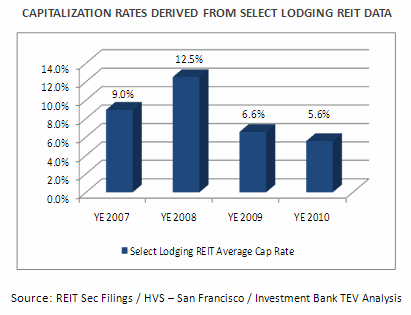
Newly formed REITS include Chesapeake Lodging REIT, which had its IPO in January of 2010 and has acquired five hotels since March of 2010; Pebblebrook, which had its IPO in December of 2009, and has acquired eight hotels since June of 2010; and the newly formed Chatham REIT, which has acquired 13 hotels since its IPO in April of 2010. This REIT activity awoke hotel owners and lenders from their paralysis. With the outlook that hotel earnings had nowhere to go but up, the risk that was perceived to be so high a year ago had now dissipated, and the public markets were jumping on board to participate in the upside that was sure to follow over the next several years. The decline in cap rates is also attributable to the increased competition for hotel assets. Transaction activity has resumed, and has been increasing its velocity since the last quarter of 2009, as noted in the following chart. More major hotel sales transactions (defined as those with purchase prices of $10 million or greater) closed in the fourth quarter of 2010 than in all of 2009. Given all of the factors currently in play, 2011 has the potential to reach the annual peak sales levels achieved from 2005 through 2007.
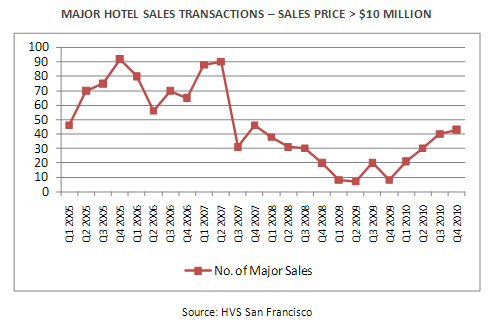
With greater availability of debt and equity capital to facilitate transactions and values trending higher, we can anticipate that more hotel lenders and owners will put their assets on the market, creating greater opportunities for the many market participants that have been sitting on the sidelines. This is likely the beginning of the usual musical chairs, where hotel investment companies work-out and/or divest of over-leveraged assets in their portfolios and look to purchase other assets with opportunity for upside.
The turnaround in the hotel investment market is further evidenced by the decline in hotel capitalization rates derived from actual sales transactions in 2010. The average capitalization rates derived from the sales price of full service hotels that sell at the time of our appraisal declined to its lowest level since we began tracking this data3. After escalating sharply to 8.0% in 2009 when hotel earnings were in a freefall, hotel capitalization rates based on historical net income declined to 4.6% in 2010. Capitalization rates based on projected first year net income declined 5.4%, also a record low. We attribute these record low rates to several factors, the most significant being the highly depressed earnings being capitalized. Once occupancy levels bottomed out in late 2009, investors began to build the expectation of a rebound in hotel earnings into their acquisition pricing. The average 2010 capitalization rate is also a reflection of the hotels that are trading hands. REITS, who were the most active players in 2010, pursued high quality assets in gateway cities; our sample only contained a few hotels that did not fit into this category. Also fueling the decline in rates was the low cost of capital, and increasing competition for the acquisition of quality hotel assets as the year progressed. Forward looking cap rates derived from first year projected net income, which are typically above the cap rate on historical net income, dipped below historical cap rates in 2009 when buyers recognized that net income was going to continue to decline before rising again. This trend reversed in 2010.
The data setting forth the historical trend in full service hotel rates of return is set forth below, followed by a graph of the same data.
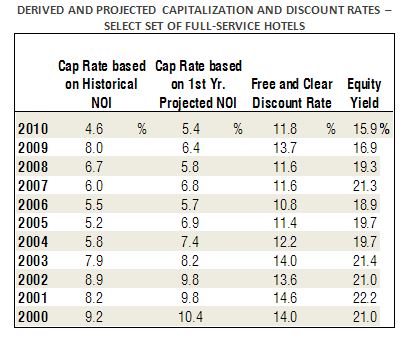
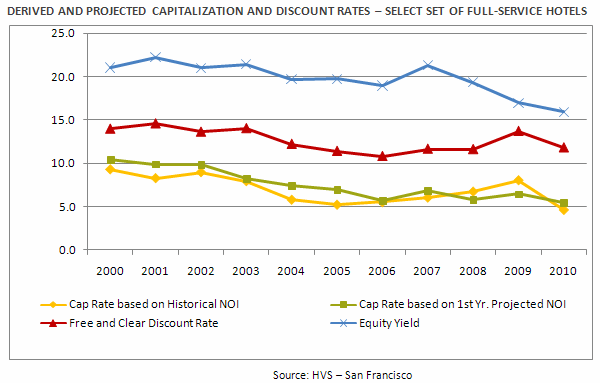
The lowest blue line reflects capitalization rates derived from sales based on trailing twelve or the most recent calendar year NOI, while the next lowest red line reflects capitalization rates derived from sales based on 1st year projected net income. With hotel performance on a clear upward trend now, investors are factoring in considerable upside into their projections over a several year period. Many US markets witnessed a strong rebound in occupancy levels in 2010, with some already reaching or exceeding past peak levels. With occupancies firming up, operators feel more confident to raise rates and pursue higher rated business; many US markets experienced a bottoming out of their ADR's in the summer of 2010, and above inflationary rate gains are anticipated over the next few years as hotels benefit from an economy gaining steam and a welcome reprieve from new supply. With strong revenue gains driven by above-inflationary rate growth, positive operating leverage is expected to drive strong increases in hotel net income levels.
Discount rates, defined as the internal rate of return equating a ten year net income projection to a value or sales price, have also declined, as evidenced by the green, second line from the top. It should be kept in mind that these yields are a product of the type of full service assets being sold and appraised at a given point in time, and thus can be skewed upward or downward, depending upon the characteristics of the hotels that form the basis for the rate calculation. A flurry of high quality assets in major metropolitan areas transacted in 2010, due in part, to the significant role played by Lodging REITS and private equity funds pursuing top tier assets in major metropolitan areas. REITS targeting discount rates from 9% to 11% have placed pressure on the hotel investment market as a whole. However, we have also seen some of the lowest capitalization rates derived from sales for older, obsolete hotel assets that have been purchased on a 'price per pound' basis. When net operating income gets very low or becomes negative, investors often are willing to pay a certain minimum price per room, and thus the relationship between price and net income becomes less relevant. While one would intuit that an older hotel, obsolete hotel located in a market with significant new additions to supply would warrant a capitalization rate at the upper end of the range, in fact, cap rates derived from sales of these types of assets may often be very low or negative. Employing a ten year discounted cash in the valuation of hotels is all the more necessary now to reflect the future upside anticipated by investors, particularly given the inexactitude of applying an overall capitalization rate to depressed net income levels.
Discount rates rose markedly in 2009, before declining to 11.8% in 2010, comparable to the levels witnessed in the most recent up-cycle from 2005 to 2008. Two years ago few pundits anticipated such a rapid return to these low levels. Even more striking is the equity yield rate, which reached a new low in 2010. While capitalization rates would be expected to be at record low levels due to the depressed earnings that are being capitalized, the equity yield rate derived from a 10-year discounted cash flow analysis overtly considers increasing net income levels and property appreciation. The lowering of equity return requirements is due to a number of factors including the perception of low risk because hotel earnings have nowhere to go but up; increasing competition for quality hotel assets which is driving up prices and thus lowering returns; lower leverage levels which inherently reduce yield and risk; and the low overall cost of both debt and equity capital. The lodging REITS have been able to raise significant sums of money in the public market based on the story of value appreciation. Industry participants remember the money that was made by the first round of investors that acquired distressed hotel assets in the early 1990’s, and do not want to miss out. While historically REITS have been popular due to their consistent payment of dividends, as of the 3rd quarter of 2010 only seven out of fourteen lodging REITS were paying dividends. The dividend yield rate ranged from .2% to 7.6% for the seven REITS that were paying dividends, with most paying dividends in the range of 2% to 4%. While investors we survey indicate they still pursue equity yields in the high teens to low 20%’s, many admit that the current investment environment has forced them to lower their return expectations to the low to upper teens, and even then they often cannot compete for the acquisition of quality assets in "gateway" markets.
The second part of the low yield equation is the cost and availability of debt. The REITS and private equity funds are availing themselves of the very low cost of revolving lines of credit to make their acquisitions. Pebblebrook's overall cost of debt, as reported in their third a quarter 10K, was 4.07%. The mortgage market has also revived, and borrowers with good track records and strong balance sheets can obtain first mortgage financing at rates ranging from 5.5% to 7.0% once again, albeit at more conservative loan-to-value ratios, typically in the 60% range, and based on stricter underwriting standards than were prevalent in the hey day of 2005 to 2007. Commercial banks, insurance companies and CMBS debt have returned as debt sources. The following chart sets forth historical yields on 10-year Treasury notes as compared with hotel mortgage interest rates of loans made by insurance companies which report to the American Council of Life Insurances Companies. As is evidenced by the graph, the spreads between the 10-year Treasuries and hotel mortgage interest rates derived from the ACLI data tightened considerable during the 2003 to 2007 period, averaging 159 basis points from the 1st quarter of 2003 to the 3rd quarter 2007, providing the low cost of debt capital that fueled the recent vibrant hotel investment market. The spread between these two indices reached an historic low of 102 basis points in the 1st quarter of 2007, the last hurrah of the most recent investment boom. By the 2nd quarter of 2009 the spread had dramatically increased to 540 bp, reflecting the uncertainty in the marketplace and the pricing of risk as hotel revenues went into a freefall.
While debt was constrained at the beginning of 2010, as the year progressed lenders began to re-enter the market. Commercial banks, regional banks and life companies began to offer both floating and fixed rate debt once more. With the Fed maintaining a low federal funds rate, and the real estate industry starved for capital, lenders could provide very favorable financing terms and still make a healthy spread. As of the second and third quarters of 2010 the spread returned to more traditional levels of roundly 300 basis points. This data reflects the terms of fixed rate mortgages. Floating rate debt tied to libor currently provides interest rates at sub 6% level, reminiscent of the debt available during the 2005 to 2007 time period.
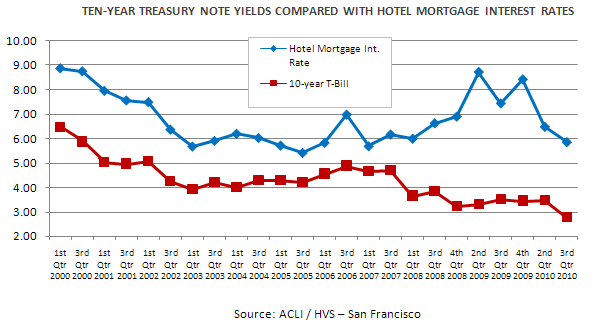
In addition to derived rates of return from sales transactions, investor surveys also provide guidance on current capitalization and discount rate trenss. The challenge with investor surveys is that even though they are based on investor forward looking return requirements, they tend to lag the market, particularly during abrupt changes in market conditions and the rates also do not always reflect the rates derived from actual sales transactions, i.e. reality may differ from expectations. The following chart sets forth Korpacz survey data for the 1st and 3rd quarters of each year since the 1st quarter of 2000. Data is set forth for three hotel categories (limited service, full service and luxury/upper upscale). Capitalization rates declined a full 200 basis points from the 1st quarter of 2003 to the 3rd quarter of 2006, and reached their nadir in the 3rd quarter of 2007. Return requirements began to rise in late 2008 but did spike until the 3rd quarter of 2009 and 1st quarter of 2010, a full year behind when the public markets recognized the market's heightened risk. As previously discussed, by early 2010 year-over-year occupancy was increasing again and rates of return began to decline because the bottom of the market had been reached; the lag in the survey data is evident. As of the third quarter of 2010 surveyed capitalization rates started to decline, and we anticipate that this trend will continue through 2011. We also note some tightening between the cap rates for limited service hotels and those of full service and luxury products. From the peak of the market in 2007 to the trough in early 2010, cap rates had increased by roundly 175 basis points for full service and luxury products, as compared with only 125 basis points for limited service hotels. We attribute this to the greater fall in the earnings of full service and luxury hotels during the downturn, while limited service hotels, with lower fixed costs and price points, generally fared better. We anticipate that this spread to widen again as full service and luxury hotels recovery their RevPAR and NOI.
Based on HVS sales and cap rate data, as well as conversations with hotel brokers, investors began lowering their return expectations for limited service properties as well as 2010 progressed, reflecting the bottoming out of the market and the increasingly availability and low cost of capital.
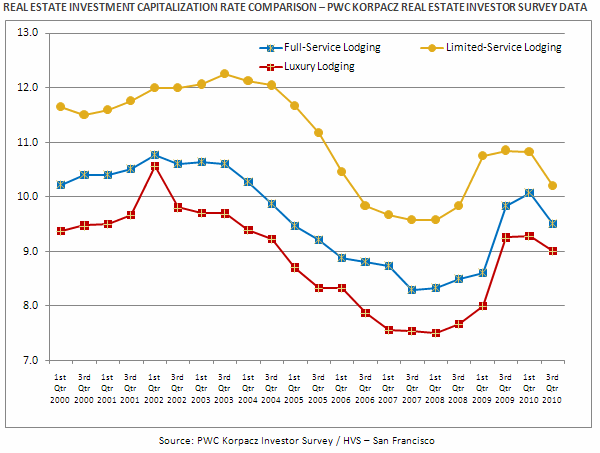
HVS data for limited service hotels that sold in 2010 based on the sales prices of hotels that sell at the time of our appraisal is set forth below; rates derived from full service hotel sales is set forth for comparison purposes. The data reflects a roundly 200 basis point spread between capitalization rates for limited service and full service hotels, and approximately a 100 basis point spread in the derived discount rate. Equity yield requirements evidence a slightly higher differential, as would be anticipated.

The following chart sets forth discount rates, or internal rate of return expectations, derived from investor surveys. The same three lodging product types are set forth, as well as discount rates for other commercial and multi-family residential real estate categories for comparison. Discount rates based on investor surveys have generally followed the same trend as capitalization rates, rising through 2008 and 2009 and reaching their peak in early 2010. Discount rates are now trending downwards and we anticipate additional lowering of yields as reported by investor surveys to continue to decline through 2011. Note the discount rates for full service and luxury hotels increased significantly in the 1st quarter of 2010, almost to the level of limited service cap rates, which had already started declining. Once again this highlights the disfavor for full service and luxury assets during an economic downturn. This trend was already reversing as of the 3rd quarter of 2010. The yield expectations for lodging actually fared better overall than for the other property types, especially retail malls, which had over a 200 basis point increase in the surveyed discount rate from the market peak in 2007 to its trough in 2010. Nonetheless, the lodging sector retained is roundly 200 basis point yield premium over that of the other real estate classes, reflecting the risk and appeal of owning hotel investments.
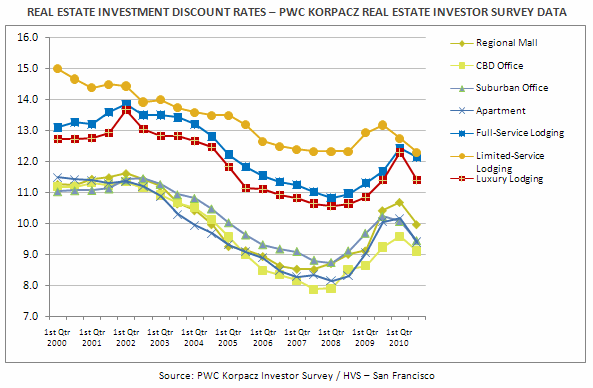
Outlook for 2011
Given all the factors at play in the hotel investment market at this time, we anticipate that capitalization rates and discount rates will continue their current low levels through 2011, barring any unforeseen shock to the industry. Interest rates are expected to remain low as the feds maintain their current monetary policy to spur economic growth. All indices point to an increasingly fluid investment environment, with sellers coming to market as increasing net income and lower capitalization rates result in value levels upon which buyers and sellers can agree. The decline in capitalization rates has had a positive impact on hotel values, with assets in some markets reaching the peak valuations achieved in the 2006 – 2007 time period, indicating that 2011 may be an excellent time to sell a hotel. Just how much of this run up in value is attributable to increases in cash flow or the lowering of rates of return varies property by property. However, it is clear that a great deal of the value gain is due to a lowering of returns at this stage of the cycle.
With the public market and private investors chasing yield, the appeal of investing in hotel assets is strong as the industry is only in the first year of what is expected to be a several year run up in earnings. As the REITS become larger and stronger their reach will expand, pricing many players out of the high quality, gateway city markets. Investors are being forced to look at turnaround situations and secondary markets and products for investment opportunities, thus putting downwards pressure on cap rates and upwards pressure on values for a wider variety of hotel assets. While REIT activity dominated the headlines in 2010, other sectors of the hotel investment community are reviving and are expected to play a larger role in transaction activity going forward.
A rising tide lifts all boats is an apt expression for the wave of value gains that is expected throughout the industry in 2011. However, we note that there are still many hotels that are and will continue to be challenged because they cannot attract well capitalized buyers and will have difficulty obtaining financing for a sales transaction. A number of hotels have been intrinsically impaired over the last decade due to aging physical plants in the face of the development of modern, new supply. No longer able to justify the investment required maintaining their brand affiliation, these assets will likely not benefit as much from the market’s recovery unless a major reinvestment can be justified by local market conditions and somehow financed. Resorts which have been challenged by their high fixed operating costs and the significant loss of group business will likely take a longer horizon to recover than commercial hotels and may languish due to their capital needs and complexity.
Looking beyond 2011, as hotel earnings continue to recover going-in capitalization rates can be expected to eventually rise as the cycle matures. REITS will eventually have to increase their dividends as the investment story shifts from value appreciation to the payment of dividends. Equity returns can be enhanced as the cycle progresses by obtaining additional leverage based on higher net income levels. And the ultimate equilibrium of rates of return will depend, in large part, upon the overall cost of capital and other investment alternatives competing for capital at the time.
2 Capitalization rates derived from REIT EBITDA less a 4% reserve divided by investment banking estimates of TEV (Total Enterprise Value) based on stock prices as of 12/31 for each year of the analysis.
3 Hotel capitalization rates are based on select full service hotel historical and projected net income at the time of sale, divided by the sales price.

0 Comments
Success
It will be displayed once approved by an administrator.
Thank you.
Error